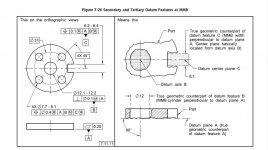SeymourDumore
Diamond
- Joined
- Aug 2, 2005
- Location
- CT
Guys, I'm having a brainfart here.
Making an absolutely idiotic looking part that is machined, then formed, then welded and then 2 final holes are added after everything else.
The two final holes are toleranced to be .2503-.2505 with a TP definition of:
j|n.005m|A|Bm|Cm
Where datums:
A is a flat surface
B and C is a hole on 2 separate planes
( damned, I thought I can cut/paste it in here ...)
Basically it says that the 2 holes must be W/in .005 (mmc) to surface A,hole B(mmc), hole C(mmc)
Now the question:
The datum holes B and C are +/-.01 diameter where
B = .3125 +/-.01
C = .375 +/-.01
What is my bonus tolerance???
Is it the .0002 given by the feature tolerance
or
Is it calculated independently for the MMC of each datum B and C, meaning
that if datum B was at basic .3125 then I get an additional .005 there
and
if datum C was at basic .375 I'd get an additional .005 there
In other words, is the bonus tolerance the given single feature MMC, or is it the sum of feature and datum MMC?
( If any of that ain't clear, please ask as this part is about to put me in the grave)
Making an absolutely idiotic looking part that is machined, then formed, then welded and then 2 final holes are added after everything else.
The two final holes are toleranced to be .2503-.2505 with a TP definition of:
j|n.005m|A|Bm|Cm
Where datums:
A is a flat surface
B and C is a hole on 2 separate planes
( damned, I thought I can cut/paste it in here ...)
Basically it says that the 2 holes must be W/in .005 (mmc) to surface A,hole B(mmc), hole C(mmc)
Now the question:
The datum holes B and C are +/-.01 diameter where
B = .3125 +/-.01
C = .375 +/-.01
What is my bonus tolerance???
Is it the .0002 given by the feature tolerance
or
Is it calculated independently for the MMC of each datum B and C, meaning
that if datum B was at basic .3125 then I get an additional .005 there
and
if datum C was at basic .375 I'd get an additional .005 there
In other words, is the bonus tolerance the given single feature MMC, or is it the sum of feature and datum MMC?
( If any of that ain't clear, please ask as this part is about to put me in the grave)


 Doesn't that mean your gaging method needs to measure to
Doesn't that mean your gaging method needs to measure to 




